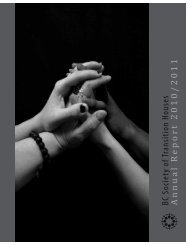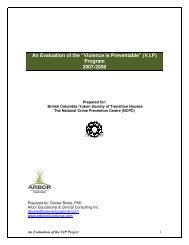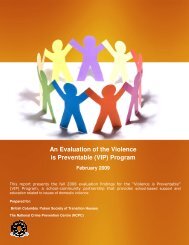reducing barriers to support - BC Society of Transition Houses
reducing barriers to support - BC Society of Transition Houses
reducing barriers to support - BC Society of Transition Houses
Create successful ePaper yourself
Turn your PDF publications into a flip-book with our unique Google optimized e-Paper software.
“Given the complex inter-relationship <strong>of</strong> life stressors, substance use<br />
and violence…. the alcohol- and drug- specific, as well as broader,<br />
work done by transition house staff appears <strong>to</strong> function as a form <strong>of</strong><br />
harm reduction <strong>to</strong> effect positive change. It is important for transition<br />
houses <strong>to</strong> acknowledge this impact <strong>of</strong> their current work, and also<br />
consider how <strong>to</strong> build upon it further.” 1<br />
INTRODUCTION<br />
In the past decade researchers and service providers internationally have increasingly focused on the<br />
connections between violence against women (VAW), mental wellness and substance use. Along with<br />
this focus has come an increase in discussion <strong>of</strong> best practices <strong>to</strong> provide <strong>support</strong> for women who have<br />
experienced violence and who have varying levels <strong>of</strong> mental wellness and substance use. Much <strong>of</strong> what<br />
has been published in regards <strong>to</strong> best practices has been targeted <strong>to</strong>wards service providers in the<br />
health sec<strong>to</strong>r. There have been a number <strong>of</strong> reports and <strong>to</strong>olkits published that identify key approaches<br />
for <strong>support</strong>ing women and collaborating across sec<strong>to</strong>rs <strong>to</strong> strengthen service approaches. Most notable,<br />
in British Columbia (<strong>BC</strong>), there have been resources published by Ending Violence Association <strong>of</strong> British<br />
Columbia 2 , the Woman Abuse Response Program at <strong>BC</strong> Women’s Hospital & Health Centre 3 , and the <strong>BC</strong><br />
Centre for Excellence for Women’s Health 4 . These resources are valuable in that they provide a starting<br />
place for discussion on what policies, procedures and practices in <strong>Transition</strong>, Second and Third Stage<br />
<strong>Houses</strong> and Safe Homes (collectively referred <strong>to</strong> as <strong>Transition</strong>al Housing) should encompass. 5 Often the<br />
recommendations come directly out <strong>of</strong> the experiences <strong>of</strong> women who have accessed or attempted <strong>to</strong><br />
access VAW services.<br />
By undertaking this project on violence against women, mental wellness and substance use, <strong>BC</strong> <strong>Society</strong><br />
<strong>of</strong> <strong>Transition</strong> <strong>Houses</strong> (<strong>BC</strong>STH) 6 hopes <strong>to</strong> build upon these efforts by collaboratively developing<br />
approaches <strong>to</strong> put these frameworks in<strong>to</strong> practice within <strong>Transition</strong>al <strong>Houses</strong> in <strong>BC</strong> and the Yukon. Our<br />
intentions are <strong>to</strong> work with service recipients and providers within the violence against women’s, mental<br />
wellness and substance use sec<strong>to</strong>rs throughout <strong>BC</strong> and the Yukon <strong>to</strong> develop guidelines for policies,<br />
procedures and practices for the VAW sec<strong>to</strong>r that integrate the frameworks that have been<br />
1






